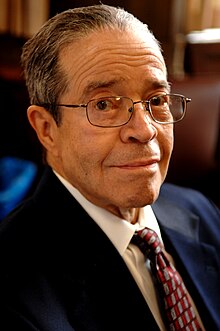J. Ernest Wilkins Jr. | |
|---|---|
 Wilkins in 2007 | |
| Born | November 27, 1923 |
| Died | May 1, 2011 (aged 87) Fountain Hills, Arizona, U.S. |
| Education | University of Chicago (BA, MS, PhD) |
| Known for | Work on nuclear physics and engineering |
| Scientific career | |
| Fields | Mathematics and physics |
| Institutions | Metallurgical Laboratory Argonne National Laboratory |
| Thesis | Multiple Integral Problems in Parametric Form in the Calculus of Variations (1942) |
| Doctoral advisor | Magnus Hestenes |
Jesse Ernest Wilkins Jr. (November 27, 1923 – May 1, 2011)[1] was an American nuclear scientist, mechanical engineer and mathematician. A child prodigy, he attended the University of Chicago at the age of 13, becoming its youngest ever student.[2][3][4] His graduation at a young age resulted in him being hailed as "the Negro Genius" in the national media.[5]
Wilkins and Eugene Wigner co-developed the Wigner-Wilkins approach for estimating the distribution of neutron energies within nuclear reactors, which is the basis for how all nuclear reactors are designed. Wilkins later went on to become the President of the American Nuclear Society in 1974.[6]
Wilkins had a widely varied career, spanning seven decades and including significant contributions to pure and applied mathematics, civil and nuclear engineering, and optics.[7] Wilkins was one of the African American scientists and technicians on the Manhattan Project during the Second World War. He also conducted nuclear physics research in both academia and industry. He wrote numerous scientific papers, served in various important posts, earned several significant awards and helped recruit minority students into the sciences.[2][8][9] During his life he was often the target of racism.[2]
- ^ Chicago Tribune. Obituary: J. Ernest Wilkins, Chicago Tribune, May 4, 2011.
- ^ a b c Cite error: The named reference
CBBwas invoked but never defined (see the help page). - ^ Mathematicians of the African Diaspora. J. Ernest Wilkins Jr., Department of Mathematics, University of Buffalo. Retrieved online May 7, 2011.
- ^ U.S. Department Of Energy, Black Contributors to Science and Energy Technology (Biographical sketch: Ernest Wilkins), U.S. Department Of Energy, Office of Public Affairs, U.S.Government Printing Office, Washington, D.C., 1979, pp. 14–15, DOE/OPA-0035(79)
- ^ Farmer, Vernon L.; Shepherd-Wynn, Evelyn (2012). Voices of Historical and Contemporary Black American Pioneers (Volume I: Medicine and Science). Praeger. p. 35. ISBN 978-0313392252. Retrieved February 27, 2021.
- ^ Atomic Heritage Foundation, 2019. https://www.atomicheritage.org/profile/j-ernest-wilkins-jr
- ^ Mickens, Ronald E. (January 18, 2013). "Obituary of J. Ernest Wilkins, Jr. (1923-2011)". Physics Today. doi:10.1063/PT.4.1695. Retrieved February 27, 2021.
- ^ University of Chicago. University of Chicago to Commemorate Accomplishments of Mathematics Alumnus J. Ernest Wilkins Jr. , University of Chicago News Office, February 27, 2007, updated July 23, 2007. Retrieved June 9, 2011.
- ^ Y., M.R., University of Chicago Magazine. The Wilkins Effect, University of Chicago, March 2, 2007. Retrieved June 9, 2011.